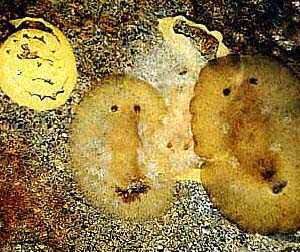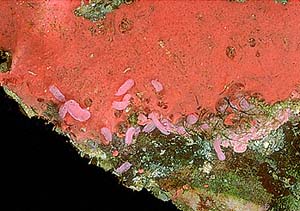Population fluctuations
April 13, 1998
From: Kirsten Benkendorff

Hi Bill,
I find several species of Opisthobranchs which suddenly appear in the intertidal area, lay their eggs and then disappear. One such species is this communally spawning Discodoris, which I do not yet have a species name for. I was wondering if anyone could enlighten me as to why they might do this. I would have thought that the intertidal area was a harsher environment in which to leave eggs than on subtidal reefs. But not being a diver myself I can't even be sure if this species is usually found in subtidal habitats.
Cheers,
Kirsten Benkendorff
Dept. Biological Science,
University of Wollongong, NSW 2522
kb06@uow.edu.au
Benkendorff, K., 1998 (Apr 13) Population fluctuations. [Message in] Sea Slug Forum. Australian Museum, Sydney. Available from http://www.seaslugforum.net/find/152
Firstly, Richard Willan has suggested your "Discodoris" is Platydoris galbanus. On your question about short term visitors, have a look at my comments on population decline at Port Stephens [#153]. When you find a couple of large Sea Slugs, mating or laying eggs, then disappearing your reasonable thought is that the animals have "migrated" to the egg-laying spot then moved away. This type of interpretation has led to many accounts of "breeding migrations" which on further study have been shown to be open to a much more simple explanation.
Most Sea Slugs, being specialist feeders, live where there food is found. In many cases they will settles out of the plankton directly on to a colony of their food or in the case of herbivores on to a food plant or place where the palnt they feed on is abundant. Since they can grow remarkably quickly if food is abundant, the apparent sudden appearance of a large population of a species may be the result of the rapid growth of larvae on abundant food rather then the migration of animals from one part of the shore to another. In the case of some Sea Hares they change the type of algae they feed on say from Red Algae to brown or Green algae as they grow. In this case it is crawling youngsters rather then swimming larvae that search out the appropriate plant. If the plant is more common intertidally, then that is where the animals will "migrate" to. Sea Slugs are hermaphrodite with a full complement of male and female organs. When they are mature they regularly mate with any available partner. Large aggregations of animals all mating are often called "mating aggregations" but we must be careful to realise that this is not a planned "orgy" but the result of their feeding behaviour leading to an aggregation of them, which in turn would lead to mating.
If you see a large aggregation, have you any evidence to show that the animals have really moved here recently on "foot"? It is more likely that the animals settled near to where you found them and were just overlooked by observers until they were big enough to be noted, or like in some Aplysia reports they were washed together by storms.
On intertidal versus subtidal living. Some species have a wide distributional range from the shallow intertidal to 30 or 40 meters deep. The Discodoris egg ribbon has been laid on the underside of a large intertidal rock, a good place to hide from predators and to stay wet. Many subtidal animals still lay their eggs in crevices and under rocks, even though they are underwater. Clearly this suggests that laying eggs under stones may protect the settling larvae from more than drying out. The most likely reason for this behaviour is to protect the slugs, and their eggs, from being eaten by fish.
A good example of animals living where they can rather than where they ought to is the small chromodorid, Noumea haliclona. It feeds on a pink and a yellow forms? species? of the sponge Darwinella. At times I have found it commonly intertidally in Sydney Harbour feeding on a yellow Darwinella and on another occasion I found a population of millions of animals all feeding on a pink intertidal form of Darwinella in northern Victoria (see photo). In the Sydney Harbour example the whole intertidal population was wiped out for over a year after a severe storm, after 2 years of little rainfall, caused huge quantities of freshwater to flow into the harbour turning the top layer of water in the harbour almost fresh and causing the death of all the sponge colonies in the intertidal and in the top half metre of the subtidal. In the northern Victorian case severe storms washed all the intertidal sponge away in 2 nights of severe storm and even a year later the intertidal population had not recovered. The subtidal however cannot be considered a refuge. While organisms are protected from drying out in the subtidal they are suddenly open to attack from a wide range of potential enemies, including fish. I guess the important lesson is that there is no general rule about such things. We need to study species, and perhaps populations, individually, as each will have its own needs and capabilities
Bill Rudman.
Related messages
-
Opisthobranchs as bio-indicator species
From: Kira Alleyne, February 8, 2006 -
Population decline - Port Stephens
From: David & Leanne Atkinson, April 22, 1998
